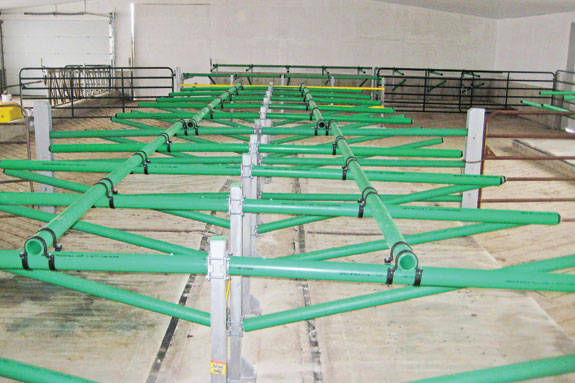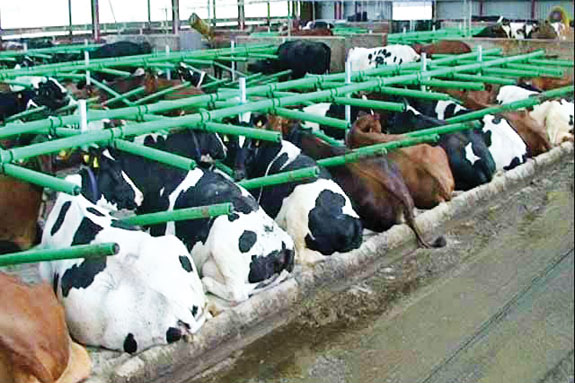This article was #1 in PDmag's Top 5 most-well read New Technology articles in 2010. Summary: The Greenfreestall, a division of Tags4All Global Inc., has created a freestall structure that is adjustable, movable and, most importantly, comfortable for cows. The sides of the design are made of composite flex piping and allow for increased flexibility. In addition, the structure adjusts in the following ways: • the height of the plastic tubes • the height of the neck bracket • the length of the neck bracket • the width of the bed Because this article was so popular, we asked John Moses of Greenfreestalls some follow-up questions:
Q: What type of interest have you received? Can you quantify it in anyway?
MOSES : Since the new technology article on the Greenfreestalls appeared in Progressive Dairyman in April of this year, sales have increased greatly.
Q: Have you made any modifications to the original product?
MOSES : We have made the Greenfreestalls fit into more existing structures by making them available for mounting on horizontal rails or mounted directly on the wall (still using our quality, heavy-duty, galvanized pipe support bracket), in addition to the original style of mounting on vertical posts.
Q: Are you working on any additional features, enhancements or new options?
MOSES : A new feature we are beginning to add to the stall option is a "brisket pipe" to run along the ground and be lagged down using our heavy-duty, galvanized floor bracket.
Q: Have any of your customers found a use or benefit you hadn’t thought of?
MOSES : Another benefit, besides the welfare of the cow, which leads to better cow health and greater milk production, is that there is a decrease in any bedding used, including sand. The cows do not have to struggle to lie down and get up, reducing kicking with their legs, and less bedding being kicked out of the stall.
Q: What is the No. 1 reason customers cite for buying this product?
MOSES : Beyond the initial reason of purchase (cow welfare leading to higher milk production), many customers comment on the way the cows adapt to the Greenfreestalls. They lie down and get up very comfortably, and remain in the stalls longer. The cows seem more relaxed in the stalls as compared to traditional metal tube freestalls. PD
PLUS, check out Progressive Dairyman 's Top 25 most well-read articles .
ARTICLE

Dairy producers wanting to give their cows the freedom of pasture while providing the safety and comfort of a building may want to consider going green. A recent invention is changing the look, design and even color of traditional freestalls.
The Green Freestall , a division of Tags4All Global Inc., has created a freestall structure that is adjustable, movable and, most importantly, comfortable for cows.
Although the Green Freestall was first created in Denmark about three years ago, the design made its first appearance in the U.S. at the 2009 World Dairy Expo. It had debuted in Canada two weeks earlier.
Canadian dairyman John Dortmans of Strathroy, Ontario, first learned about Green Freestall from an advertisement in a dairy newspaper. He also spoke with his relatives from Holland, who knew of a nearby farm using the stalls.
Dortmans says what intrigued him most about the new design was the freedom of movement.
“There’s no way that a cow can get caught in these stalls,” Dortmans says. “You never have a cow that gets in distress.”

Last fall, Dortmans became the first farm in North America to install the innovative design, putting in 47 stalls in a newly constructed barn for his breeding-age heifers and dry cows.
At first, Dortmans had used the same stall width and head rail placement for both the heifers and the dry cows, but soon realized he wanted different measurements for the heifers than the cows.
“It was as simple as adjusting a few screws,” Dortmans says. Even the installation itself “wasn’t rocket science,” he says, and compared it to piecing together a puzzle.
He appreciated the fact that the design is so customizable, and he was able to easily figure out his options for fastening the stalls.
The structure adjusts in the following ways:
• the height of the plastic tubes
• the height of the neck bracket
• the length of the neck bracket
• the width of the bed
The width of the freestall is fully adjustable. The plastic tubes, made of round rubber, sit at a 75-degree angle and measure 86.61 inches long. The height of the neck bracket is also adjustable.
The plastic tubes that divide the stalls from each other have a huge amount of flex, Dortmans says.
“As soon as the pressure is released, the tube comes right back to where it was,” he says.
For the time being, Dortmans milks his 60-cow herd in a tiestall, but he hopes to someday transition to a freestall and parlor setup. And the Green Freestall design for his milking herd would be a no-brainer.
“Cows aren’t afraid to use these stalls,” he says. “And comfort is key. Comfortable cows make more milk.”
Increased cow comfort and increased milk production are the biggest selling points of the design, says John Moses, president of Green Freestall.
“If the cows are comfortable, they lay longer. If they lay longer, they make more milk,” Moses says. “That increased volume of milk makes the stall pay for itself.”
Another benefit of the stalls is that they could be considered a more humane housing alternative.
“Traditional steel freestalls have created lumps, caused injuries and, in some cases, broken the backs of cows,” Moses says. “The Green Freestall gives cows the flexibility to get up and down and in and out of the stall.”
Dortmans agrees.
“A lot of farms have recently been labeled as not being ‘animal friendly’” he says. “Whether we like it or not, that’s something we’re going to have to pay more attention to.”
Since completing the barn in November 2009, Dortmans has received calls and visitors from fellow producers, including a few in Pennsylvania and Wisconsin. He says he has given similar advice to all of those who were interested.
“If I didn’t think the stalls worked, I’d tell people that,” he says. “But we’ve had no complaints at all, and I haven’t found anything that we should have done differently [when installing].” PD
PHOTOS
ABOVE RIGHT : John Dortmans of Ontario, Canada, was the first North American dairyman to use the Green Freestall design. He says both he and his cattle are pleased with the results. ABOVE LEFT : The width of the stalls and the neck rail can be adjusted to fit different breeds and sizes of cows. Photos courtesy of The Green Freestall.
To view video footage of the stalls from John Dortmans’ operation, play the video below or visit http://www.greenfreestall.com/





